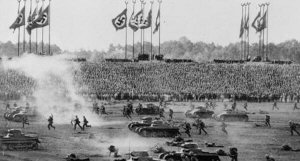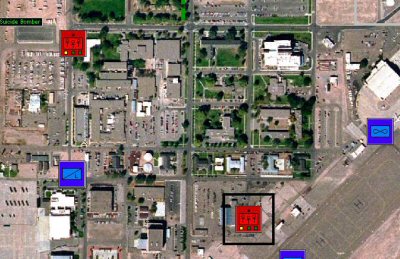Historical Simulations
From the beginning, military professionals have calculated their chances of success in future war by evaluating the available statistics on past wars. From Sun Tzu and Machiavelli to Jomini and Clauswitz, men have tried to capture the essence of war and provide formulas, principles and theories on how it can be waged successfully. Generally, this has been done by reading about or participating in historical battles, analyzing them in one form or another and then extrapolating the results to future war. Some observers, like Jomini, were more concerned with identifying unchanging principles and patterns while others, like Clausewitz, were more interested in the philosophical aspects of war. Still others have spent their lives attempting to understand the historical lessons of war by quantifying them. In other words, they think in numerical terms when conducting military analysis. The idea is that by quantifying warfare they may better understand the complex relationship between such things as the number and type of weapons and manner employed by each side and the number of casualties suffered. For the military professional interested in understanding and applying the historical lessons of combat as derived from quantitative military historical analysis, the historical simulation has been and will continue to be a very powerful tool. But what is a historical simulation and what specifically does it provide to the military professional that a good history book, film or staff ride does not? Before answering that question it is first necessary to understand some of the history of military simulations.
{default}
Picture from the first European Chess Essay by Alfonso El Sagon (1221-1228)
In the beginning . . .
Military simulations, or wargames, have been around for a very long time. Chess, considered to be one of the oldest surviving ancient wargames, goes back thousands of years. It is a highly abstracted simulation but it is relatively accurate for the period it covers, the pre-gunpowder era. Each of the pieces has its own capability and starting position. The board itself is flat and featureless. Players may move only one piece per turn. While simple, these rules represent the fact that soldiers in ancient battles also had clearly defined roles, typically fought on clear flat ground and because command and control was so poor, could only control a small portion of their forces at any given time. [1]

Frederick the Great
As more education and technical sophistication developed over time, military simulations became more advanced. In the 17th century the first "modern" wargames appeared. Many of these early simulations were nothing more than sophisticated variations of chess but they now used playing boards that represented real terrain and playing pieces that more accurately portrayed contemporary soldiers and their capabilities. By the early 19th century, the Prussians developed what has been described by one author as "the first detailed and realistic wargames." [2] Used for training, planning and testing military operations, they were developed by carefully studying actual historical battles. By 1871, most European armies had followed what the Germans were doing with wargaming, however, few took it as seriously or derived as much from it. Although most military simulations during this period confined themselves to single battles, larger operations were "gamed" but were more likely to be an administrative exercise of moving men and material to the right place at the right time. [3]
World War II and beyond . . .
During World War II, the Germans continued their practice of conducting military simulations and regularly gamed historical, current and future operations. In fact, the manual simulations they used are very similar to current manual wargames. The British, Russians and Japanese were also active in this regard and gamed most major operations in one way or another. Unfortunately, in the United States only the Navy regularly used military simulations. [4]

German troops in a mock battle at Nurenmberg on September 12, 1937
After the war the continuing development and application of computers, operations analysis and systems analysis resulted in the idea that military simulations not only could, but also had to, provide "precise and unambiguous" answers through gaming. It also created an atmosphere in which traditional, history-based, manual wargames were not considered "precise" enough for the needs of the professional military. Unfortunately, this ignored the fact that history-based manual wargames, although relatively imprecise in some aspects, generally achieved the "95 percent solution" which was certainly accurate enough to be useful. Moreover, as time passed we have realized that operations and systems analysis although precise, may not be as reliable and accurate as once hoped. This has generally meant that not every aspect of a military simulation, historical or otherwise, can be modeled with absolute accuracy nor does it necessarily need to be. The problem of accuracy remains a trade-off between the complex nature of war and how much time and resources (or computer processing speed and memory) are available. Putting military simulations on a PC does not necessarily represent "ground truth" but it is a powerful device for crunching the numbers necessary in pursuit of the "99 percent solution." [5]
The historical simulation . . .
While many military professionals are quite satisfied with reading a book or watching a film on a historical battle or campaign, a military professional who games that same event is looking for something more. Specifically, he or she uses simulation to do a closer examination and evaluation of all the aspects associated with the battle in question. Because after all, isn’t a wargame a historical account of an event in simulation form? Arguably, the first and most important step in any historical simulation is the research and organization of the data involved. The quantitative analysis of this information is no small feat but it is also not the subject of this paper. Suffice to say the data must be reliable and correctly interpreted since it will later serve as the foundation for model development. Perhaps it is obvious but one of the easiest aspects of military affairs to quantify and make consistently meaningful are weapons and their effects since they obey the standard law of physics. But even this relatively predictable performance tends to wander when employed on the battlefield, just ask any soldier. So the process of understanding and then applying the seemingly endless number of combat variables, such as weather, terrain and morale and their effects on weapons performance and thus battle outcomes, is critical. And this is precisely what the military professional can and should learn from historical simulations. [6]

Point of Attack 2 (HPS Simulations) – A modern tactical wargame
If military history is the "professional officer’s laboratory of war," [7]Â then the historical simulation is a critical means for experimentation. No other medium of historical study allows the military professional to manipulate the key elements of a battle, campaign or war and then test the outcome with the same expectation of historical accuracy. By comparison, when was the last time you explored the "what if?" aspect of a historical battle through a book or a film? By manipulating the key elements of a historical battle through simulation, the military professional gains a better understanding of how all important aspects of the battle interacted. Moreover, it provides a unique opportunity to explore alternative strategies and tactics. In fact, many wargamers do not game at all. They simply study and manipulate the simulation by themselves. While useful, I think playing solitaire eliminates a crucial aspect of war. Namely, there are typically two sides in a military conflict and each is attempting to impose its will on the other. With both sides exercising free will, the number of "what ifs?" to explore grows considerably but realistically.
In conclusion . . .
By duplicating a historical event through the recreation of those key elements that the original participants had to consider and then allowing it to be manipulated or "gamed," I believe every military professional can gain a substantially better understanding of military history. Anything less is little more than following someone else’s historical understanding of the battle. Only a historical simulation frees the military professional from the linear journey of a book or film in which it is impossible to consider alternatives. In contrast, a military simulation is nonlinear, much like the event itself. This means a military professional can wander through the event, changing variables if desired and still be in context. Whether looking for the future in the past, validating new techniques through historical models, or simply wanting to do some professional development, there is no more powerful, practical and useful analytical device than a historical simulation. The question should not be, "what can a military professional learn from historical simulations?" I think that is quite clear. The question should be, "why are they not used more extensively within the professional military educational system?"
Notes
[1] James Dunnigan, The Complete Wargames Handbook (New York: William Morrow and Company, 1992), p.146.
[2] ibid.
[3] ibid.
[4] Dunnigan, 234-235
[5] Dunnigan, 236.
[6] Colonel T.N. Dupuy, US Army, Ret., Numbers, Predictions and War: Using History to Evaluate Combat Factors and Predict the Outcome of Battles (Fairfax: HERO Books, 1985) p 3-6.
[7] Department of the Army, US Army Command and General Staff College, C610, The Evolution of Modern Warfare, Book of Readings (Fort Leavenworth: USACGSC, April 1991), Preface
Bibliography
Dunnigan, James F. The Complete Wargames Handbook. New York: William Morrow and Company, 1992.
Dupuy, T.N. Colonel, US Army, Ret. Numbers, Predictions and War: Using History to Evaluate Combat Factors and Predict the Outcome of Battles. Fairfax: HERO
Books, 1985.
U.S., Department of the Army, US Army Command and General Staff College. C610,
The Evolution of Modern Warfare, Book of Readings. Fort Leavenworth:
USACGSC, August 1997.
Image I. From the following website
Image II. From Henri Decalt’s Free Kriegspiel Pages
Image III. Source unknown
Image IV. HPS Simulations. Point of Attack 2.

